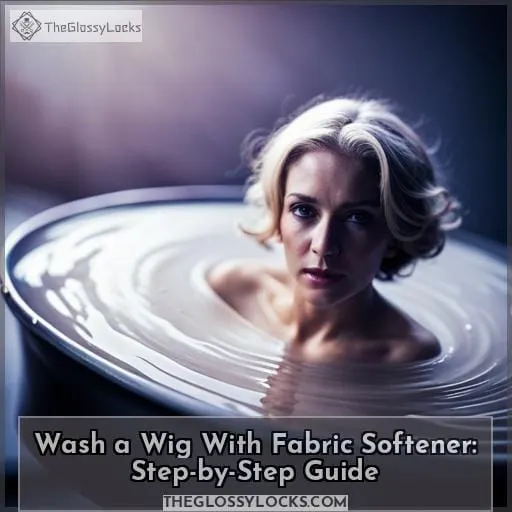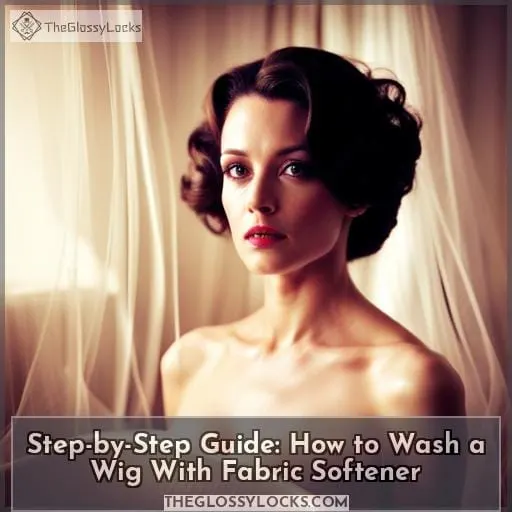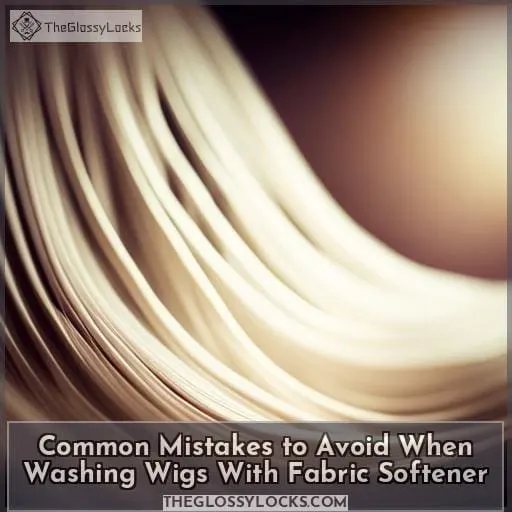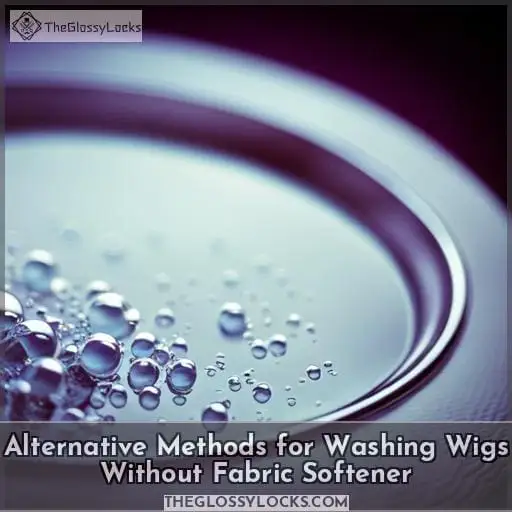This site is supported by our readers. We may earn a commission, at no cost to you, if you purchase through links.
 Imagine stepping into a world of vibrant hair, where your wig shines with brilliance and feels irresistibly soft. Discover the secret to achieving this transformation as we guide you through the process of washing a wig with fabric softener.
Imagine stepping into a world of vibrant hair, where your wig shines with brilliance and feels irresistibly soft. Discover the secret to achieving this transformation as we guide you through the process of washing a wig with fabric softener.
In this step-by-step guide, you’ll learn how to enhance the luster and manageability of your synthetic wigs using a simple yet effective method.
Let’s dive in and unlock the power of fabric softener for your wig care routine.
Table Of Contents
- Key Takeaways
- Benefits of Using Fabric Softener for Washing Wigs
- Step-by-Step Guide: How to Wash a Wig With Fabric Softener
- How Often Should You Wash Your Wig?
- Tips for Maintaining the Luster of Synthetic Wigs
- Common Mistakes to Avoid When Washing Wigs With Fabric Softener
- What is Fabric Softener and How Does It Work?
- Understanding Synthetic Wigs and Their Care
- Choosing the Right Brush for Synthetic Hair
- Alternative Methods for Washing Wigs Without Fabric Softener
- Tips for General Wig Care and Maintenance
- Frequently Asked Questions (FAQs)
- Can I use fabric softener on human hair wigs?
- Will fabric softener damage or fade the color of my synthetic wig?
- How long does it take for a wig to air dry after washing with fabric softener?
- Can I use fabric softener sheets instead of liquid fabric softener on my wig?
- Is it necessary to use fabric softener every time I wash my wig, or can I skip it occasionally?
- Conclusion
Key Takeaways
- Fabric softener restores luster and softness to dull wigs.
- It reduces frizz, tangles, and static electricity in wig strands.
- Proper care and storage after washing with fabric softener prolongs the wig’s lifespan.
- There are two methods to wash a wig with fabric softener: using a spray bottle or soaking.
Benefits of Using Fabric Softener for Washing Wigs
When it comes to washing wigs, using fabric softener has several benefits.
First and foremost, it enhances the shine of the wig, making it look vibrant and healthy.
Additionally, fabric softener helps to reduce static electricity build-up in the hair fibers and detangles any knots or tangles that may have formed during wear.
Lastly, proper care and storage after washing with fabric softener can help prolong the lifespan of your wig by keeping it in optimal condition.
Enhanced shine and softness
Achieve enhanced shine and softness in your synthetic wigs by washing them with fabric softener.
The benefits of using fabric softener for washing wigs are numerous:
- It restores luster to dull-looking wigs, giving them a beautiful sheen.
- It leaves the hair feeling incredibly soft and smooth, making it more comfortable to wear.
- Fabric softeners help reduce frizz and tangles, allowing for easier styling and maintenance of your wig’s appearance.
By incorporating fabric softener into your wig care routine, you can enjoy the benefits of shiny, silky-soft hair that looks amazing every time you wear it!
Reduced static and tangles
To achieve reduced static and tangles when washing wigs with fabric softener, you’ll need to follow these steps.
Fabric softener helps to minimize friction between the hair fibers of the wig, preventing them from tangling and causing static electricity.
By using fabric softener during the washing process, you can maintain smoothness and manageability in your wig’s hair strands. This will result in a more polished appearance and make styling much easier after washing.
Proper care and storage
For optimal results, it’s important to properly care for and store your wig after washing it with fabric softener.
To ensure the longevity of your wig, avoid excessive heat and harsh chemicals.
Store it in a cool, dry place away from direct sunlight.
Regularly brush your wig to prevent tangles and knots. This will also help reduce static electricity build-up.
Following these steps will keep your wig looking beautiful and maintain its softness and shine for longer periods of time without causing any damage or frizzing.
Step-by-Step Guide: How to Wash a Wig With Fabric Softener
Let’s dive into the step-by-step guide on how to wash a wig with fabric softener.
There are two methods you can choose from:
- Using a spray bottle
- Soaking the wig
Both methods are effective in restoring shine, detangling hair, and reducing static electricity.
Method 1 – Spray Bottle
Spray the fabric softener solution onto the synthetic wig using a spray bottle, ensuring that all areas of the wig are evenly coated.
To determine how much fabric softener to use, consider the length and thickness of your wig.
Avoid using hot water as it can damage synthetic hair fibers.
Allow the fabric softener to penetrate by letting it soak for about 10-15 minutes before rinsing thoroughly with cold water.
Remember to brush your wig regularly to prevent tangles and maintain its shape and style.
Method 2 – Soaking
Now, let’s move on to the second method of washing a wig with fabric softener: soaking.
Soaking your wig in a fabric softener solution is an effective way to restore its shine and soften the hair fibers. To begin, fill a basin or sink with cold water and add enough fabric softener to create a diluted mixture.
The exact amount will depend on the size of your wig, but generally, you should use about 1/4 cup of fabric softener for every gallon of water. Immerse your wig in the solution and allow it to soak for approximately 15-30 minutes.
Be careful not to exceed this time as prolonged soaking can damage synthetic wigs.
During this time, the fabric softener will work its magic by detangling knots and reducing static electricity build-up within the hair fibers. However, it’s essential not to use too much fabric softener as excess product can leave behind residue that weighs down your wig or makes it look greasy.
After soaking for the recommended duration has passed, gently swish around your wig in circular motions within the water before removing it from the basin/sink carefully (avoid wringing or twisting). Rinse thoroughly under cool running water until all traces of fabric softener have been removed.
How Often Should You Wash Your Wig?
To maintain the cleanliness and freshness of your wig, it’s important to wash it regularly. How often you should wash your wig depends on various factors such as how frequently you wear it and the type of hair fibers used.
-
Synthetic wigs:
- It’s recommended to wash synthetic wigs every 7-10 days if they’re made from polyester fiber, acrylic fiber, nylon fiber, wool fiber, or silk fiber.
- However, if you wear an acrylic wig more often or engage in activities that cause sweat or dirt buildup on the wig cap, weekly washing may be necessary.
-
Human hair wigs:
- Human hair wigs require less frequent washing compared to synthetic ones.
- It’s generally advised to change your human hair wig at least every 6 months; however daily maintenance routines like brushing can help keep them looking fresh between cleanings.
Remember these key points when deciding how often to wash your wig:
- Daily cleaning with dry shampoo can remove excess oil and odor without water.
- Conditioning with a specialized product helps restore moisture and softness.
- Avoid excessive exposure of heat styling tools like curling irons for extended periods.
- Use hairspray sparingly as too much product buildup can affect the appearance of your wig over time.
- Store your clean and dry-wig properly on a stand or mannequin head covered with a breathable fabric cover.
By following these tips for regular care and proper maintenance intervals based on usage frequency ,you will ensure that both synthetic & natural-hair options stay vibrant longer!
Tips for Maintaining the Luster of Synthetic Wigs
To maintain the luster of your synthetic wig, you should regularly care for it and follow these tips:
- Avoid excessive heat:
- Heat can damage the fibers of your wig, causing them to lose their shine and become frizzy.
- It’s best to avoid using hot styling tools or exposing your wig to direct sunlight.
- Store properly:
- Proper storage is essential to maintaining the luster of your synthetic wig.
- When not in use, store it in a cool and dry place away from direct light.
- Avoid storing it near harsh chemicals or strong odors that could potentially damage the fibers.
- Brush regularly:
- Regular brushing helps prevent tangles and keeps your wig looking smooth and shiny.
- Use a wide-toothed comb or a brush specifically designed for wigs to gently detangle any knots starting from the bottom up.
By following these tips, you can ensure that your synthetic wig maintains its beautiful luster for longer periods of time without losing its shine due to excessive heat exposure or improper storage techniques.
Common Mistakes to Avoid When Washing Wigs With Fabric Softener
To ensure the best results when washing wigs with fabric softener, it’s important to avoid common mistakes.
One mistake to avoid is using too much fabric softener. While fabric softener can help restore shine and soften the hair fibers of your wig, using an excessive amount can leave a residue that weighs down the hair and makes it appear greasy.
Another mistake to steer clear of is skipping the rinsing step after soaking or washing your wig with fabric softener. Rinsing ensures that any leftover product or dirt is thoroughly removed from the wig, preventing buildup and maintaining its cleanliness.
Using hot water when washing a synthetic wig with fabric softener should also be avoided as it can damage the fibers and cause them to become frizzy or lose their shape. Instead, opt for cold water which helps preserve both color vibrancy and overall integrity.
Lastly, agitating your wig too vigorously during cleaning can lead to tangling or even potential breakage of strands. It’s essential to handle your wig gently while applying gentle pressure during cleansing motions.
By avoiding these common mistakes – using too much fabric softener, skipping rinsing steps after soaking/washing sessions; utilizing hot instead of cold water temperatures; agitating wigs aggressively throughout cleanings – you’ll be able maintain optimal condition in terms healthiness & attractiveness without compromising quality over time!
What is Fabric Softener and How Does It Work?
Now that you know the common mistakes to avoid when washing wigs with fabric softener, let’s delve into what fabric softener is and how it works its magic.
Fabric softener is a product specifically designed to make clothes feel smooth and silky while reducing stiffness and roughness after washing. It contains a combination of ingredients that work together to achieve these benefits.
- Quaternary Ammonium Compounds (Quats): These are the primary active ingredients in fabric softeners, responsible for reducing static cling.
- Fragrances: Added to give your clothes a fresh scent.
- Emulsifiers: Help distribute the active ingredients evenly on fabrics.
- pH adjusters: Maintain an optimal pH level for effectiveness.
-
Fabric Softener History:
Fabric softeners have been used since ancient times when people discovered various ways of making their garments softer using natural substances like fats or oils derived from plants or animals.
-
Types of Fabric Softeners:
There are two main types of fabric softeners available in liquid form and dryer sheets/softening balls used during drying cycles.
-
Benefits of Using Fabric Softeners:
- Softer, smoother fabrics
- Reduced wrinkles
- Enhanced fragrance
5.FabricSoftner Alternatives:
If you prefer not to use conventional fabric softenrs due allergiesor environmental reasons there are alternative methods available such as vinegar, baking soda,and wool drying balls which can also help soften your laundry without chemicals
Understanding Synthetic Wigs and Their Care
First, let’s understand synthetic wigs and how to properly care for them.
Synthetic wigs are made from man-made materials such as polyester fiber, acrylic fiber, nylon fiber, wool fiber, or silk fiber. They’re designed to mimic the look and feel of natural hair at an affordable price point.
Caring for synthetic wigs is important to maintain their appearance and longevity.
When it comes to washing synthetic wigs with fabric softener benefits can be seen in:
- Restoring shine
- Detangling the hair fibers
- Reducing static electricity buildup
- Softening the wig overall.
These benefits can keep your wig looking beautiful while also improving its durability.
Various brands of fabric softeners exist in markets including Woolite, Tide, Ariel, All Free, and Seventh Generation. However if you prefer alternatives there are other methods available like using a mixture of vinegar or baking soda.
Fabric Softeners typically contain ingredients that help soften fabrics like silicone-based compounds, cationic surfactants, emulsifiers, preservatives, coloring agents, and fragrance. Whether you choose traditional fabric softeners or alternative methods, the goal is always gentle cleaning without damaging your wig.
Soaking, washing, rinsing, drying, storing correctly all contribute towards maintaining a healthy lifespan for your beloved synthethetic tresses!
In conclusion, it’s essential to understand how best we should take care our syntheitc hairs by knowing about different types available, focussing on proper storage techniques, in addition safegaurding against harsh chemicaals will enhance shelf life.
Additionally understanding various ways Fabric Softner helps us manage our synthetci locks provides valuable insights into enhancing maintenance routines.
Choosing the Right Brush for Synthetic Hair
When it comes to choosing the right brush for synthetic hair, there are a few options to consider.
- One option is a wide-toothed comb or pallet brush, which can help detangle the wig without causing damage.
- Another option is a wig-specific brush with soft bristles that are designed to be gentle on synthetic fibers.
It’s important to choose a brush that suits your specific needs and preferences in order to maintain the quality and longevity of your synthetic wig.
Synthetic wig brush options
Continuing from our previous discussion on understanding synthetic wigs and their care, let’s now delve into the various options for synthetic wig brushes and how to choose the right one for your hairpiece.
When it comes to brushing a synthetic wig, you have several options to consider.
- A wide-tooth comb is a great choice for gently detangling the hair without causing damage.
- Another option is a boar bristle brush, which helps distribute natural oils and adds shine to the wig.
- A paddle brush can be used for general styling purposes, while a detangling brush is specifically designed to remove knots and tangles from the hair fibers.
- Lastly, if you want extra volume or texture in your hairstyle, you can use a teasing brush.
Choosing the right brush
To choose the right brush for synthetic hair, consider the specific needs of your wig and opt for a brush that’s designed to gently detangle and style synthetic fibers.
A wide comb or pallet brush works well for long wigs, as it helps prevent excessive pulling or tugging.
A boar bristle brush is great for adding shine and smoothing out shorter styles.
If you have a thick wig with lots of volume, a paddle brush can help distribute oils evenly while reducing frizz.
For creating texture or adding volume at the roots, a teasing brush is ideal.
Brushing techniques for wigs
To maintain your synthetic wig’s appearance and minimize tangles, regularly brush it gently from the roots to the ends using a wide-tooth comb or pallet brush.
Avoid using a hair dryer or heat styling tools on your wig as this can cause damage.
It’s important to store your wig properly when not in use to prevent tangling and preserve its shape.
By brushing gently with the right tool and following proper storage techniques, you can keep your synthetic wig looking beautiful for longer periods of time.
Alternative Methods for Washing Wigs Without Fabric Softener
If you prefer not to use fabric softener, there are alternative methods for washing wigs without it.
-
Dry Shampoo and Conditioner:
- Use a dry shampoo specifically designed for synthetic hair to absorb excess oils and refresh the wig between washes.
- Follow up with a lightweight conditioner spray to keep the strands moisturized.
-
Baking Soda and Vinegar:
- Create a mixture of equal parts baking soda and water, then apply it all over the wig, gently massaging into the fibers.
- Rinse thoroughly with cold water before soaking the wig in diluted vinegar (one part vinegar, three parts water) for 10-15 minutes.
- Rinse again with cold water until clean.
-
Baby Shampoo and Conditioner:
- Dilute baby shampoo in lukewarm or cool water and gently massage it into your wig.
- Rinse thoroughly and follow up with a gentle conditioner to restore moisture without weighing down the hair fibers.
-
Dry Cleaning or Professional Wig Cleaning Services:
- If you’re unsure about cleaning your own wig or want to be extra cautious, you can opt for professional dry cleaning services specially designed for wigs.
- They know how to handle different types of wigs properly and ensure they are cleaned thoroughly while maintaining their integrity.
- It’s always best to consult an expert when in doubt!
Remember that regardless of which method you choose, it’s important to use a good quality wig cap to catch any loose strands during the washing process, and use a wig brush to gently detangle the hair after it has dried completely.
These alternative methods provide effective alternatives to wash your wig in order to maintain its beauty and exlongevity.
Tips for General Wig Care and Maintenance
To keep your wig looking its best, it’s important to follow some general tips for care and maintenance.
-
Store Wig Properly:
- When not in use, store your wig on a wig stand or mannequin head to help maintain its shape and prevent tangles.
- Avoid storing it in direct sunlight or near heat sources as this can cause damage.
-
Avoid Tangles:
- Gently brush your wig with a wide-toothed comb or paddle brush before and after each wear to remove any knots or tangles.
- Start from the ends of the hair and work your way up towards the roots using light strokes.
-
Avoid Heat:
- Synthetic wigs are sensitive to heat, so avoid exposing them directly to high temperatures such as curling irons, straighteners, or hot water when washing them. Opt for cool water instead.
Additionally, using a wig cap can provide an extra layer of protection between your scalp oils and the cap of the wig while helping secure it in place during wear.
Lastly, allow your wet wig to dry naturally by placing it on a wig stand or rack. This will help maintain its shape and prevent any potential damage due to high temperatures from hair dryers or other heating tools.
Incorporating these simple tips into your regular wig care routine will ensure that your wig maintains its shine and looks its best for as long as possible.
Frequently Asked Questions (FAQs)
Can I use fabric softener on human hair wigs?
Yes, fabric softener can be used on human hair wigs.
It helps to restore shine, detangle the hair, reduce static electricity and soften the hair fibers.
Follow the same steps as washing synthetic wigs with fabric softener.
Will fabric softener damage or fade the color of my synthetic wig?
Fabric softener won’t damage or fade the color of your synthetic wig when used properly.
The gentle formula is designed to enhance the shine and softness of the hair fibers without causing any harm.
How long does it take for a wig to air dry after washing with fabric softener?
After washing your synthetic wig with fabric softener, it generally takes overnight for the wig to air dry completely.
Ensure that you place it in a well-ventilated area away from direct heat or sunlight for optimal drying time and results.
Can I use fabric softener sheets instead of liquid fabric softener on my wig?
Yes, you can use fabric softener sheets instead of liquid fabric softener on your wig.
Simply rub the sheet over the surface of the wig to impart a soft and smooth texture.
However, be sure to avoid using excessive amounts as it may leave residue on the hair fibers.
Is it necessary to use fabric softener every time I wash my wig, or can I skip it occasionally?
Skipping fabric softener occasionally won’t harm your wig, but using it regularly will maintain its softness, shine, and manageability. Consistency is key in preserving the quality of your wig and ensuring long-lasting beauty.
Conclusion
To sum it up, washing a wig with fabric softener can work wonders for enhancing its shine, softness, and manageability. By following our step-by-step guide, you can achieve glamorous locks that radiate confidence.
Remember to choose the right brush for synthetic hair and avoid common mistakes when washing wigs.
Additionally, we’ve provided alternative methods for washing wigs without fabric softener, ensuring you have options that suit your needs.
With proper care and maintenance, your wig will always look vibrant and lustrous.













